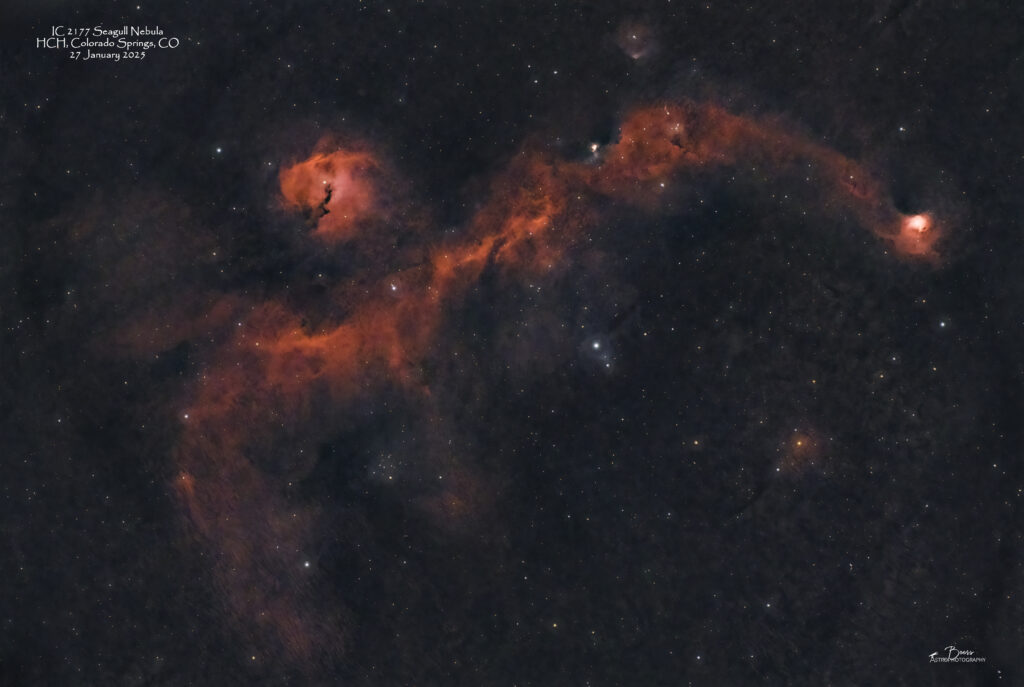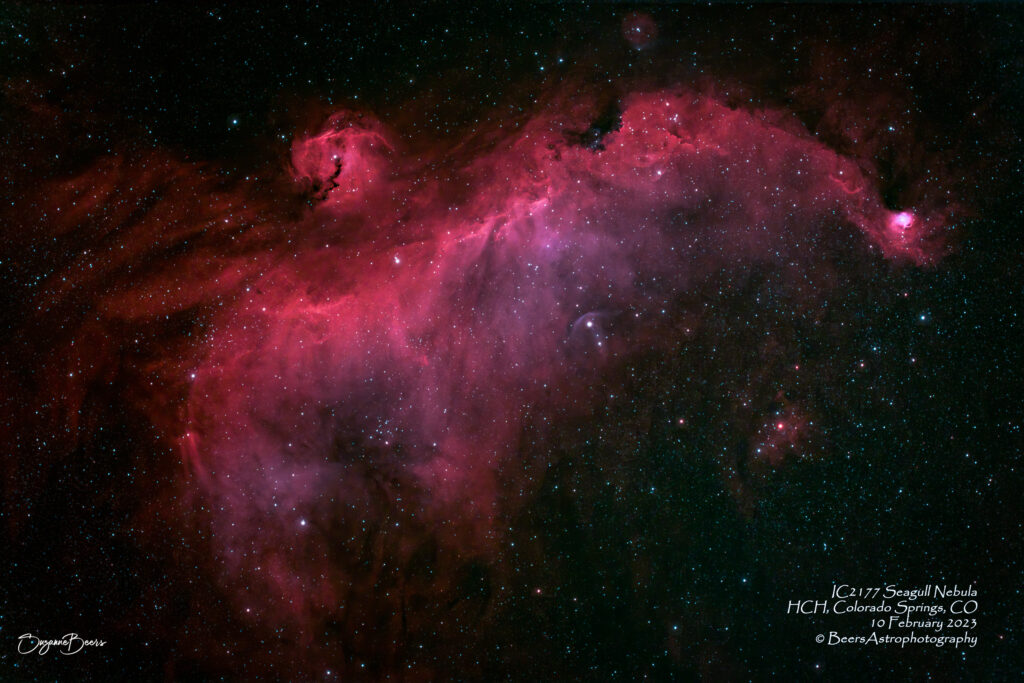
Fun facts
IC 2177 is a region of nebulosity that lies along the border between the constellations Monoceros and Canis Major. It is a roughly circular HII region centered on the Be star HD 53367. This nebula was discovered by Welsh amateur astronomer Isaac Roberts and was described by him as “pretty bright, extremely large, irregularly round, very diffuse.”
The name Seagull Nebula is sometimes applied by amateur astronomers to this emission region, although it more properly includes the neighboring regions of star clusters, dust clouds and reflection nebulae. This latter region includes the open clusters NGC 2335 and NGC 2343. NGC 2327 is located in IC 2177. It is also known as the Seagull’s Head, due to its larger presence in the Seagull nebula.
Other Catalog Designations: GUM 1, IC 2177, Sh2-292
Subtype: Reflection Nebula
Distance from Earth: 3650 light years
Visual Magnitude: 6.97
Constellation: Monoceros
{From: https://en.wikipedia.org/wiki/IC_2177 }
Capture Notes
During our dark skies trip to the Kiowa National Grasslands over the New Years Eve weekend, it occurred to me that it would be great to be able to stay inside the Beast to control and check on the equipment without having to go outside into the elements. A ZWO ASIAIR-like set-up (https://www.zwoastro.com/product-category/asiair/) without their proprietary solution would be ideal. I mentioned the idea to Paul on the drive home.
Being the problem-solver that he is, Paul jumped right on the latest BeersAP “I need” or “it would be great if I had” challenge… He designed and fabricated a transmitter/receiver set-up with a 50-foot length of Cat 6 cabling running between them, that I am nicknaming the “Baye-Aire.” I used the completed Baye-Aire product to image during the January New Moon nights from the front patio, to test it out before we took it to the field on a dark skies trip.
This image of IC2177 Seagull Nebula captured on 27Jan2025 represents “first light” with the Baye-Aire. Everything worked perfectly! If you are interested, check out the blog (link to be inserted once it is completed) for a full description of the Baye-Aire equipment and operations.
As an aside, I have moved this gallery’s previously featured image of IC2177 to the “other images” section below…not because I think this image is better – just because it is newer. I actually prefer the February 2023 image captured with the ASI2400MC on the Southern Cross, using an Optolong LeXtreme light pollution filter to this one captured with the ZWO ASI2400MC on the Southern Cross, using an Optolong LPro light pollution filter. That, by the way, makes 2-for-2 on the previously captured images using an LeXtreme light pollution filter being the more appealing image vs. those imaged using the LPro light pollution filter – at least in my opinion. See https://beersastrophotography.com/gallery/ic1805-heart-nebula/ for the other recent example (i.e., the following night’s imaging of IC1805 Heart Nebula).
Equipment
All equipment controlled by HP Probook (DSO-CTRL1) running Sequence Generator Pro v4.4.1.1441.
- Imaging (ASI2400-SC-LPro): (Southern Cross) ZWO ASI2400MC imaging camera, Askar FRA600 108mm f/5.6 Quintuplet Petzval Flat-Field Astrograph, Optolong L-Pro light pollution filter
- Mount: Rainbow Astro RST-135E (controlled by iHubo ASCOM driver)
- Polar alignment: QHYCCD camera (controlled by Polemaster for polar alignment)
- Autoguiding: Orion 60mm Multi-Use Guide Scope with Orion StarShoot AutoGuider Pro Mono Astrophotography Camera (controlled by PHD2)
- Remote connection: (Baye-Aire) AV Access U2EX50 USB2.0 Extender 60m Receiver/Transmitter connected with 50’ Cat 6 communication cable
Summary
Sequence plans: Gain 158, Offset 30, Temp 0°C; 66x5min. Captured 27Jan2025, 19:17MST – 28Jan2025, 02:23MST. Total exposure time: 5:30hrs.
Equipment: Southern Cross (Askar FRA600, ZWO2400MC) with LPro LP filter on Rainbow Astro RST-135
Capture: 27 January 2025
Shooting location: Colorado Springs, Colorado
Processing: Captured in SGP, stacked in APP, star removal with Starnet++, processed in LR/PS.
Other images of IC2177 Seagull Nebula

Capture Notes
This image was “first light” with the ZWO ASI2400MC and Askar FRA600 on the Rainbow Astro RC-135E – the Southern Cross (so named for its purpose to travel (on aircraft vs in the Beast) to the Southern Hemisphere). After struggling with power cables for a month after receiving the new ZWO ASI2400MC imaging camera, I was finally in the position to run both the ASI2400MC and the RC-135E mount. We had a clear night before I need to leave for our DAF SAB DOT study panel trip to Edwards AFB. I had planned to shoot Thor’s Helmet with Big Zeus, but decided that I should learn what was required to attach and focus the ASI2400 to the Askar FRA600 before I got to the dark skies location with something missing to complete the set-up. It took a little bit during the middle of the day to assemble the attachment and figure out how to get the light pollution filter into the imaging train. But once everything was set up, it didn’t take too long to achieve focus and get going with the imagining.
Equipment
All equipment controlled by HP Probook running Sequence Generator Pro v3.2.0.660.
Polar alignment: QHYCCD camera (controlled by Polemaster)
Imaging stream: ZWO ASI2400MC imaging camera with Optolong LeXtreme light pollution filter; (Southern Cross) Askar FRA600 108mm f/5.6 Quintuplet Petzval Flat-Field Astrograph
Mount: Rainbow Astro RC-135E (controlled by iHubo)
Autoguider: Orion 60mm Multi-Use Guide Scope, Orion StarShoot AutoGuider Pro Mono Astrophotography Camera (controlled by PHD2)
Summary
Sequence plans: Gain: 158, Temp: -0°C, no offset. 63x5min. Total exposure time: 5:15hrs. Captured 10Feb2023, 1933MST – 11Feb2023, 0110MST.
Equipment:
Capture: 10 February 2023
Shooting location: Colorado Springs, Colorado
Processing: Stacked in APP, processed in LR/PS.
